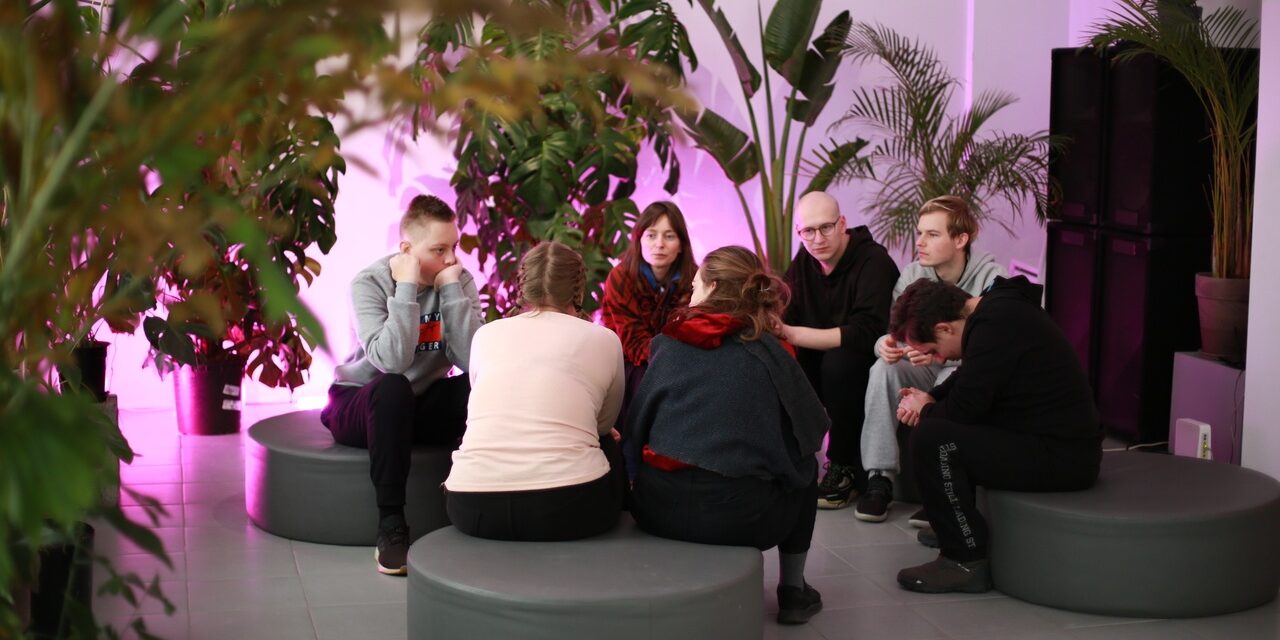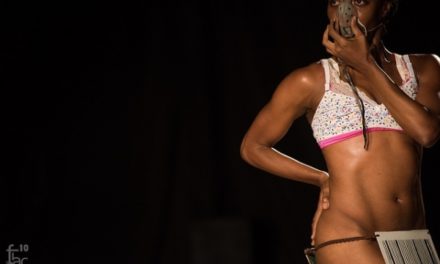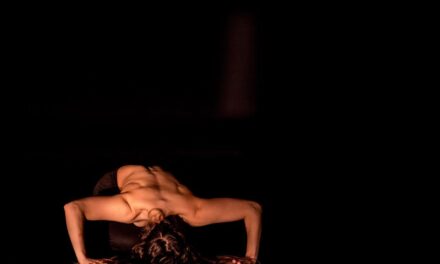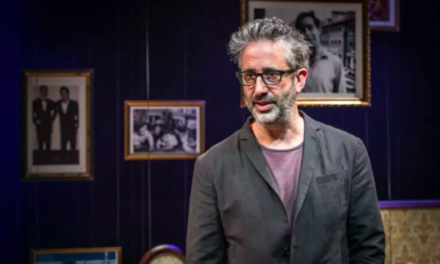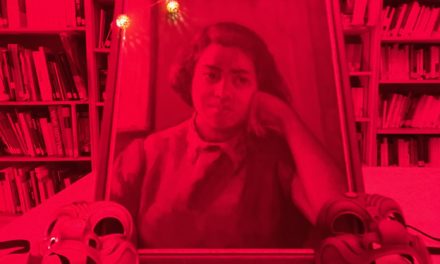A short documentary opening the series entitled Spradyczni artyści (Sporadic Artists, dir. Małgorzata Jakubowska in collaboration with Magdalena Mucha, 2020) premiered at this year’s Between.Pomiędzy festival in Gdańsk. It is part of a larger project Najdziwniejszy Androgyn (The Strangest Androgyne) which centers on people on the autistic spectrum. Initiated by Polish stage and costume designer and anthropologist, Magdalena Mucha, the project involved artistic and theatre workshops and gave rise to a series of short documentary films that seek to give insight into the lives of four young people on the autistic spectrum.
The very title Najdziwniejszy Androgyn does not so much allude to the gender or sexual identities of the individuals presented in the film (although some aspects of this issue will be explored in the films) as refers to Hieronymus Bosch’s The Garden of Earthly Delights. The left-wing of the early modern triptych features a strange figure – a curious hybrid of a whale, bird, and human being. This liminal, not-fully-human Other is holding an open book in their hands. Mucha sees the book as a symbol of creative power given to the lonely individual suspended between the human and the non-human world.

Detail of “The Garden of Earthly Delights” by Hieronymus Bosch, from left panel “Adam and Eve”, lower right corner. Painted between 1480 and 1505.
Yet, the creators of the project do not see themselves as those who endow the neurodivergent Other with creative power, but rather as providers of a democratic and egalitarian space for creativity, self-expression, and mutual understanding. What served as the main part of the project started was a workshop (organized at the Colony of Artists, an art center in Gdańsk-Wrzeszcz) whose open structure catered for the individual interests of the participants. Much as the workshop offered a form of entertainment, it also created occasions for conversation and for a search for a common language to express the experiences of those whom society often fails to understand. The encounters between all the artists involved in the project also took place in a less formal space. One of the outcomes of these meetings and creative collaborations is a series of short films. The first one, which was shown at Between.Pomiędzy festival is a less-than-five-minute-long collage of images (we see the participants at the workshop and in familiar places) and observations of the world offered by four young neurodivergent Poles (Kamil Andrzej Bączkowski, Jacek Kaszuba, Maksymilian Karwowski, and Aleksandra Ostach) and their carers (Anna Bączkowska, Julia Jedynak, Izabela Minga, and Joanna Ostach).
In the previous paragraph, I intentionally used the word “artists” to refer to both autistic and non-autistic participants in the workshop and creators of the film. As the very title of the documentary series suggests, the non-professionals were also given the status of artists. What they contributed to the film are their insightful comments and unique experiences of the world, which they share in an open and honest way with the viewers. In fact, when asked whether he considers himself as an artist, Kamil Andrzej Bączkowski called himself “a sporadic artist” (hence the title of the series), thus claiming the status. In a conversation with Małgorzata Woźniak and Janusz Mosakowski, Jakubowska also mentioned that she and other professionals involved in the project see the fellow participants as artists because they have a similar outlook on the world. As Mucha further explained (in a private interview), people on the autistic spectrum do not develop the same patterns of understanding the world as non-autistic people. Like artists, they build their own, unique worlds.
The short film that premiered in Gdańsk featured, among other things, scenes from the everyday lives of the “sporadic artists” who had earlier agreed that Magdalena Mucha should film one day of their lives. This concept strongly resonates in the Polish context and, particularly, the recent debate on To tylko kilka dni (It’s Only for a Few Days) – a TV show aired by the popular Polish TV station TVN. In each episode, a Polish celebrity (helped by a team of advisors) spends a few days assisting a person with a disability, i.e. taking over the responsibilities usually performed by the family members who take a few days off. The concept raised a lot of objections from the Polish disability community (see e.g.: a commentary from disability activist Katarzyna Bierzanowska). TVN was accused of using people with disabilities instrumentally and placing the focus on the celebrities depicted as agents of positive change in others and their own lives (they are supposed to “bring some good energy and new perspectives” into the lives of those in their care as well as find a moment for reflection and “appreciate what they have” (Dzień dobry TVN). This demonstrates that while the Polish mainstream media have noticed the underrepresentation of people with disabilities, they are now trying to capitalize on it without developing ethical strategies of empowerment and representation. That is why projects that follow a different representational path are so much needed these days, not only in Poland.
In Jakubowska and Mucha’s short film, we see teenage Maksymilian Karwowski sitting on a swing and explaining his very specific plans for the future. He intends to be a TV presenter and work for different popular TV stations. Karwowski speaks with precision and confidence, which makes the audience question their possible initial reactions of doubt or disbelief caused by the fact that they have probably seen less than few (if any) disabled (or neurodiverse) people in the mainstream media presented as anything other than charity cases. As Michel Bérubé notes, the question of disability representation is not limited to aesthetic concerns (i.e. the way disability is depicted), but it also refers to “a mechanism by which one person or group of people is empowered to stand in for and express the wishes of another person or group” (i.e. having one’s representatives in a given field). Thus, rather than watching Polish non-disabled celebrities’ transformative experience of assisting people with disabilities “for just a few days,” I look forward to seeing more (neuro)diverse people, like Karwowski, work in the Polish media.
Jakubowska and Mucha’s short film is largely based on the conversations that the film crew had with the four young people on the autistic spectrum and their carers. In less than five minutes, it offers an apt commentary on the constructedness and arbitrary nature of the so-called “norm.” Aleksandra Ostach, for instance, openly states: “I don’t feel ill. I feel normal,” and people often perceive her as such (in fact, since autism often presents differently in girls, many of them have remained undiagnosed till later in life). Her words powerfully challenge the medical discourse which is introduced in the opening fragments when we observe the participants in the workshop and hear their mothers’ voices who explain that from the very beginning they knew “there was something wrong” with their children. The medical model, which sees disability as an aberration that needs to be fixed, also prevails in Aleksandra’s own statements in which she refers to her condition using the word “illness.” In fact, the film shows ableism not only as a problem that is deeply rooted in the world in which the four people on the autistic spectrum live, but also as a largely internalized form of prejudice. This is, for instance, conspicuous in Bączkowski’s fear of being labeled as mentally ill and his desire to fit in. Although never mentioned in the film, the word “disabled,” understood in accordance with the social model of disability, in many ways defines the people that are shown on the screen. What disables them is not so much the fact of being autistic, but rather a lack of understanding, and social alienation, which has often led to depression.
The film is dominated by greyish and dull colors. The images occasionally become blurred, suggesting the participants’ wish to blend in with the world which frequently sees them solely through the prism of their neuroatypicality. In her powerful 2004 article in which she comes out as bipolar, Suzanne J. Fiala, MD writes about one of the reasons why for many years she chose to pass as non-disabled: “If my colleagues knew that I was bipolar, I fear that I would never again be taken seriously, that I would be viewed as the ‘impaired physician’ who, at a display of passion or emotion, would be seen as having an ‘episode.’ […]. My right to express even normal anger or irritability, happiness, or my effervescent sense of humor would be suspected as pathological. I would lose the right to just have a bad day.” In a similar vein, in Jakubowska and Mucha’s film Ostach mentions that when she said something that her friend did not like, she was told that she is “fucked-up” and even has “a medical certificate to prove that.”
The film strongly accentuates the social model of disability as well as the specificity of the Polish context in which recent disability activism was propelled as much by people with disabilities as by their families. The latter created an informal group RON (Rodzice Osób Niepełnosprawnych, Parents of Disabled People) and together with their (adult) children in 2018 started a forty-day-long sit-in at the Polish parliament. The active involvement of the parents in the protest was scrupulously used by their political opponents who stated that disabled “children” were “held hostage by their parents” (Krynicka) and treated as “human shields” (Żalek), which raises the question of whether the sit-in would have been more successful if the parents had not put themselves in the spotlight. Jakubowska and Mucha do not render the parents (or, specifically, mothers) and their interdependent relationships with their children invisible. Although the carers are visually absent from the first episode of “Sporadyczni artyści,” their stories are heard. Yet, the focus is on the four young people on the autistic spectrum who dominate the screen and are provided ample space to give the viewers an insight into their lives, in line with the famous dictum “nothing about us, without us.”
What gave rise to the project Najdziwniejszy Androgyn was Mucha’s curiosity and desire to learn more about a fascinating group of people who function in the world in a non-standard way. As Rosemarie Garland-Thomson notes, curiosity, which often finds expression in what she calls “baroque staring,” “can lead to new insights.”[1] Alluding to Susan Sontag, she further notes that “[i]f starers can identify with starees enough to jumpstart a sympathetic response that is then ‘translated into action,’ staring turns the corner toward the ethical.”[2] I strongly believe that the first episode of the film series gives the viewers an opportunity to exercise “good staring,” reflect on the social model of disability, and, consequently, take political action.
The collaborative, egalitarian, and democratic creative strategies employed in the project stimulate mutual understanding (rather than offering a one-sided exploration of the neurodivergent Other). This is particularly important in the Poland where debates on disability representation are slowly beginning to enter the mainstream, for instance in the context of the earlier mentioned To tylko kilka dni or Malina Prześluga’s play Debil (Idiot) which won the prestigious Gdynia Dramaturgical Prize in 2020. Lauded as the “first Polish dramatic text that gives voice to a mentally disabled person [sic!]” (Flader-Rzeszowska), it attempts to challenge the common perception of individuals with intellectual disability as innocent eternal children by taking recourse to yet another harmful ableist cliché – the figure of an evil crip. Populated by a myriad of stereotypes, Prześluga’s text does not give the reader access to the authentic experiences of Polish people with intellectual disability. As the author herself explains, she is not familiar with these experiences, as she has met very few people with intellectual disability in her life. Thus, the play is intended as a form of self-reflection and self-criticism, which yet does not go beyond ableist stereotypes or give voice to those whom it allegedly represents (for a more detailed analysis and criticism of the play, see: Justyna Lipko-Konieczna and Monika Świerkosz).
Najdziwniejszy Androgyn follows a different path, creating opportunities for empowerment, ethical representation, and good staring. Mucha describes her participation in the project in terms of being let into the world of people on the autistic spectrum, which gives her a better (yet by no means full) understanding of their perspectives. As a quite neurotypical person myself, I prefer to think about it in terms of expanding the boundaries of my world and making it more diverse.
[1] Rosemarie Garland-Thomson, Staring: How We Look, Oxford UP, 2009, p. 51.
[2] Ibidem, p. 188.
This post was written by the author in their personal capacity.The opinions expressed in this article are the author’s own and do not reflect the view of The Theatre Times, their staff or collaborators.
This post was written by Katarzyna Ojrzyńska.
The views expressed here belong to the author and do not necessarily reflect our views and opinions.

